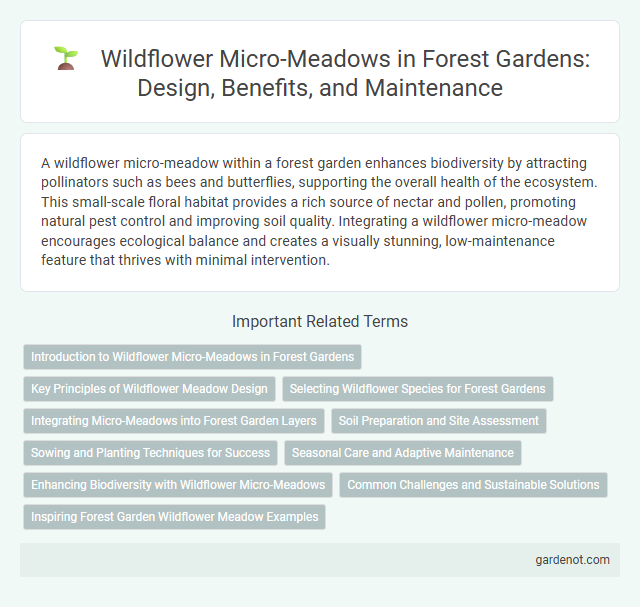A wildflower micro-meadow within a forest garden enhances biodiversity by attracting pollinators such as bees and butterflies, supporting the overall health of the ecosystem. This small-scale floral habitat provides a rich source of nectar and pollen, promoting natural pest control and improving soil quality. Integrating a wildflower micro-meadow encourages ecological balance and creates a visually stunning, low-maintenance feature that thrives with minimal intervention.
Introduction to Wildflower Micro-Meadows in Forest Gardens
Wildflower micro-meadows in forest gardens enhance biodiversity by supporting pollinators and beneficial insects crucial for ecosystem health. These small, diverse plantings create habitats that improve soil quality through natural nutrient cycling and reduce erosion. Incorporating native wildflower species ensures resilience and sustainability, fostering a balanced, self-sufficient garden environment.
Key Principles of Wildflower Meadow Design
Wildflower micro-meadows thrive by prioritizing biodiversity through the selection of native wildflower species adapted to local soil and climate conditions. Designing for layered vegetation structure encourages pollinator habitats, enhances soil health, and sustains overall ecosystem resilience. Implementing low-maintenance management techniques like seasonal mowing and controlled grazing supports natural regeneration and long-term meadow vitality.
Selecting Wildflower Species for Forest Gardens
Selecting wildflower species for forest gardens enhances biodiversity and supports pollinators vital for ecosystem health. Native wildflowers such as Trillium, bloodroot, and wild columbine thrive under the canopy, offering seasonal blooms that enrich soil quality and attract beneficial insects. Incorporating shade-tolerant species with varied bloom times ensures continuous floral resources, promoting a resilient and self-sustaining forest garden micro-meadow.
Integrating Micro-Meadows into Forest Garden Layers
Integrating wildflower micro-meadows within forest garden layers enhances biodiversity by providing vital habitats for pollinators and beneficial insects. These micro-meadows, strategically planted in sunlit gaps and under canopy edges, improve soil health through diverse root structures and organic matter contribution. Incorporating native wildflowers supports ecosystem resilience and promotes natural pest control, enriching the overall productivity of forest gardens.
Soil Preparation and Site Assessment
Preparing soil for a wildflower micro-meadow involves testing pH levels and nutrient content to ensure optimal conditions for native species. Site assessment includes evaluating sunlight exposure, drainage patterns, and existing vegetation to select appropriate seed mixes that promote biodiversity. Effective soil loosening and weed removal enhance root establishment and long-term meadow health.
Sowing and Planting Techniques for Success
Sowing wildflower micro-meadows requires preparing well-drained, nutrient-poor soil to mimic natural conditions that favor native species. Techniques such as shallow sowing and light raking promote optimal seed-to-soil contact, enhancing germination rates. Timing is crucial; early spring or late autumn sowing aligns with natural plant cycles, increasing establishment success in forest garden ecosystems.
Seasonal Care and Adaptive Maintenance
Seasonal care for a wildflower micro-meadow involves targeted mowing and selective weeding to encourage native species growth and prevent invasive plant dominance. Adaptive maintenance requires monitoring soil health and moisture, adjusting irrigation and nutrient input based on weather patterns and plant responses. Timely removal of seed heads promotes biodiversity by allowing diverse wildflower species to thrive throughout different seasons.
Enhancing Biodiversity with Wildflower Micro-Meadows
Wildflower micro-meadows significantly enhance biodiversity by providing diverse habitats for pollinators such as bees, butterflies, and other beneficial insects. These small-scale ecosystems support native flora and fauna, promoting ecological balance and resilience within forest gardens. Implementing wildflower micro-meadows increases plant species richness and improves soil health, fostering sustainable forest garden environments.
Common Challenges and Sustainable Solutions
Wildflower micro-meadows often face challenges such as invasive species encroachment, soil nutrient depletion, and irregular moisture levels. Implementing sustainable solutions like native species selection, mulching to retain soil moisture, and periodic manual weeding enhances biodiversity and resilience. These practices support ecosystem services, promoting pollinator habitats and natural pest control within forest gardens.
Inspiring Forest Garden Wildflower Meadow Examples
Wildflower micro-meadows in forest gardens create vibrant ecosystems by blending native blooms like bluebells, foxgloves, and primroses that attract pollinators and support biodiversity. These miniature meadows mimic natural woodland clearings, fostering seasonal beauty and wildlife habitats within compact garden spaces. Examples such as the RHS Wisley Forest Garden demonstrate how integrating wildflower micro-meadows enhances ecological balance and aesthetic appeal in sustainable garden design.
Wildflower micro-meadow Infographic

 gardenot.com
gardenot.com